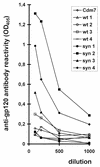Increased immune response elicited by DNA vaccination with a synthetic gp120 sequence with optimized codon usage
- PMID: 9445053
- PMCID: PMC124631
- DOI: 10.1128/JVI.72.2.1497-1503.1998
Increased immune response elicited by DNA vaccination with a synthetic gp120 sequence with optimized codon usage
Abstract
DNA vaccination elicits humoral and cellular immune responses and has been shown to confer protection against several viral, bacterial, and parasitic pathogens. Here we report that optimized codon usage of an injected DNA sequence considerably increases both humoral and cellular immune responses. We recently generated a synthetic human immunodeficiency virus type 1 gp120 sequence in which most wild-type codons were replaced with codons from highly expressed human genes (syngp120). In vitro expression of syngp120 is considerably increased in comparison to that of the respective wild-type sequence. In BALB/c mice, DNA immunization with syngp120 resulted in significantly increased antibody titers and cytotoxic T-lymphocyte reactivity, suggesting a direct correlation between expression levels and the immune response. Moreover, syngp120 is characterized by rev-independent expression and a low risk of recombination with viral sequences. Thus, synthetic genes with optimized codon usage represent a novel strategy to increase the efficacy and safety of DNA vaccination.
Figures






References
-
- Almond N, Kent K, Cranage M, Rud E, Clarke B, Stott E J. Protection by attenuated simian immunodeficiency virus in macaques against challenge with virus-infected cells. Lancet. 1995;345:1342–1344. - PubMed
-
- Barry M A, Lai W C, Johnston S A. Protection against mycoplasma infection using expression-library immunization. Nature. 1995;377:632–635. - PubMed
-
- Berman P W, Gregory T J, Riddle L, Nakamura G R, Champe M A, Porter J P, Wurm F M, Hershberg R D, Cobb E K, Eichberg J W. Protection of chimpanzees from infection by HIV-1 after vaccination with recombinant glycoprotein gp120 but not gp160. Nature. 1990;345:622–625. - PubMed
-
- Boehm W, Kuhroeber A, Paier T, Mertens T, Reimann J, Schirmbeck R. DNA vector constructs that prime hepatitis B surface antigen-specific cytotoxic T lymphocyte and antibody responses in mice after intramuscular injection. J Immunol Methods. 1996;193:29–40. - PubMed
-
- Boyer J D, Ugen K E, Wang B, Agadjanyan M, Gilbert L, Bagarazzi M L, Chattergoon M, Frost P, Javadian A, Williams W V, Refaeli Y, Ciccarelli R B, McCallus D, Coney L, Weiner D. Protection of chimpanzees from high-dose heterologous HIV-1 challenge by DNA vaccination. Nat Med. 1997;3:526–532. - PubMed
Publication types
MeSH terms
Substances
LinkOut - more resources
Full Text Sources
Other Literature Sources
Medical

